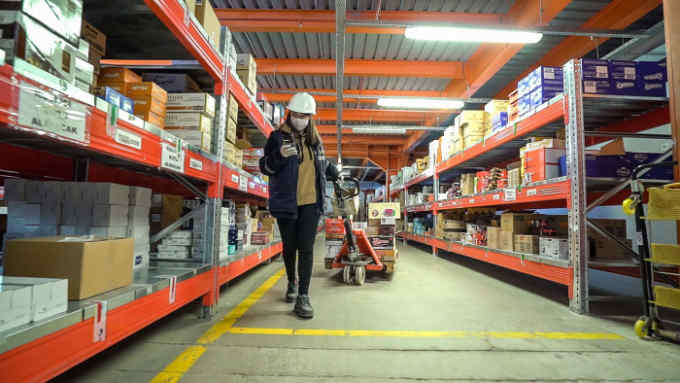Pandemic strains shipping, air and rail freight operators

Roula Khalaf, Editor of the FT, selects her favourite stories in this weekly newsletter.
It would be easy watching the freight trains rumbling through Camden Road station in central London to assume that everything in the world’s logistics system was working as normal.
One recent lunchtime, a locomotive belonging to GB Railfreight, one of the UK’s biggest rail freight operators, sounded its horn as it headed through the station. It was hauling 32 wagons loaded with shipping containers from Felixstowe, the UK’s busiest container port, to a distribution facility near Birmingham. Another train, operated by DB Schenker, the logistics arm of Germany’s Deutsche Bahn, passed it hauling containers in the opposite direction.
Yet the apparent normality masks a profound trauma affecting the world’s logistics system. Earlier this year it was hit by coronavirus-related disruption in China’s factories and is now suffering from an unprecedented collapse in demand in North America and Europe.
John Smith, GB Railfreight’s managing director, says his company is grappling with drops in containerised exports from the UK of as much as 50 to 60 per cent, while imports are also declining.
“People are scared to spend their money, particularly on some of the goods coming in,” Mr Smith says. “Wine is doing well but, generally, in terms of your discretionary spend, we’re certainly seeing demand drying up.”
Richard Wilding, professor of supply chain management at the UK’s Cranfield School of Management, says that, even before the crisis, new manufacturing technologies and narrowing wealth differentials between countries were pushing manufacturers to produce goods closer to big consumer markets.
Coronavirus, which has raised questions about the wisdom of maintaining the pre-virus lean inventories and geographically long supply chains, is likely to encourage that trend.
“Covid-19 has . . . accelerated change dramatically within this whole area,” Prof Wilding says. “This is why, when we come out of this, I do not believe things are going to go back to normal.”
At the heart of the challenges is a system that had grown steadily over the past 50 years to offer a huge array of ways to move goods promptly and at low cost from manufacturing hubs, such as China’s Pearl River Delta, to big consumer markets.
In normal times, customers have a range of potential routes to move goods to market — from the quick but expensive option of airfreight to the more economical option of shipping containers by sea. The system’s reliability and flexibility meant customers buying these goods had little need to maintain large inventories of stock themselves.
Shipping suffered a series of disruptions as coronavirus spread around the world: port authorities have forced some ships to observe 14-day quarantine periods at anchor before entering some ports.
Shipping lines are also grappling with how and whether to make changes to crews on vessels as they reach the end of their tour of duty. Some lines have preferred to keep previous crews on board, to avoid the risk of bringing the virus aboard vessels, while others have sought to continue crew changes but with extra safeguards.

Prof Wilding says that one of the biggest remaining causes of disruption has been that some countries’ lockdown procedures have meant empty shipping containers have been piling up in consumer countries and not returning to manufacturing ones.
Air freight capacity, meanwhile, has suffered severely from the cancellation of passenger flights. “What people often overlook is it’s passengers upstairs and freight below,” Prof Wilding says. “That has meant a ramping up of the cost of air freight.”
However, according to Tim Power, managing director of London-based Drewry Shipping Consultants, the risk for the core long-distance mode in the sector — container shipping — is that spare capacity will send prices plummeting, threatening operators’ viability.
Drewry estimates that volumes handled by container ports — which even in hard times normally rise year-on-year — will be down more than 15 per cent in this year’s second quarter. Far less severe demand shocks in the past have sent shipping lines scrambling to cut rates to keep their vessels full and sent rates plummeting, plunging operators into losses and threatening instability for all in the sector of the kind that followed the 2016 collapse of Hanjin, the Korean shipping line.
Mr Power insists lines have so far managed the challenge well by cancelling vessel sailings to limit the pressure to cut rates. Drewry’s World Container Index — an average of rates for a 40ft container on a series of long-distance routes worldwide — stood at $1,542 for the week ending May 14, around the same levels that were prevailing for most of November and December, before the effects of the virus was felt.
“Rates are reasonably stable,” Mr Power says. “What that means is that they’re managing the losses in this down period by taking out as much cost as they can and by sustaining freight rates.”
The question for shipping lines is whether they will maintain the discipline required to avoid a collapse in rates.
The challenges are similar for Mr Smith at GB Railfreight. His company originally saw a lull in its intermodal — or container — business when Chinese factories took extended Chinese new year breaks in January and February to control the virus’s spread. Demand then returned until well into April as UK retailers and manufacturers rebuilt depleted stocks.
However, trains like the one at Camden Road are increasingly running with empty spaces as demand falls — and Mr Smith expects fierce price competition from trucking companies as they seek to capture market share from rail.
“I think we’re looking at three to four months of severe downturn in the imports,” Mr Smith says.
Letter in response to this article:
Navigating shipping’s path to sustainability / From Dr Zhong Sheng, Research Fellow, Energy Studies Institute, National University of Singapore, Singapore

Comments